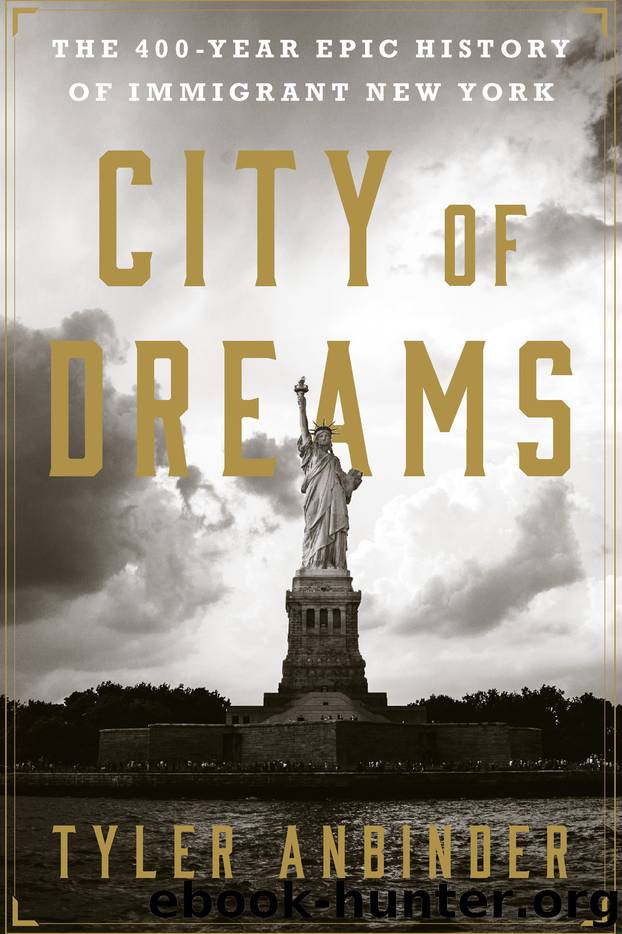City of Dreams by Tyler Anbinder

Author:Tyler Anbinder
Language: eng
Format: epub
Publisher: Houghton Mifflin Harcourt
Jacob Riis’s photograph of Bandit’s Roost (an alleyway between 57 and 59 Mulberry Street) helped establish Mulberry Bend’s reputation as one of the most decrepit and dangerous blocks of tenements ever inhabited by New York immigrants.
The overwhelming majority of reporting on Italian immigrants’ tenements focused on Mulberry Bend and its vicinity, even though only a small minority of the city’s Italian immigrants lived there. We have far fewer descriptions of the tenements in New York’s other Italian enclaves. We do know that the Italians’ West Village and SoHo housing, built originally for middle-class native-born New Yorkers or relatively well-to-do Irish immigrants, should have been better than that near Mulberry Bend, especially as one moved north toward Washington Square, since these tenements tended to be newer and less run-down.
By contrast, the Italian enclave around Houston Street was within the city’s light manufacturing district. On many of these blocks, especially in the western portion of the neighborhood, tenements alternated with large commercial loft spaces. In the late twentieth century, apartments on these blocks became highly prized because of the lofts’ high ceilings and spacious floor plans. But in the earliest decades of the century, the factories located in these lofts created noise and air pollution that made life for the neighborhood’s residents especially uncomfortable, in particular for those immigrants who had come to New York from the bucolic Italian countryside. Asked if she liked New York, one Italian immigrant said: “Not much, not much. Good money, good people, but my country—my country—good air, much air, nice air down Italy.” In New York, there was “good money, but no good air.”17
Another disadvantage of the SoHo–West Village enclave was the terrible overcrowding. Rather than take in a boarder or two as the Irish had done to help make ends meet, Italians tended to share their apartments with an entire second family. In the district’s typical three-room apartments, one family might occupy one room while the boarding family slept in the second. The third room—the kitchen—would be used by both. In some three- and four-room apartments, three families might share the space. Riis found a tenement on Elizabeth Street in which forty-three families inhabited sixteen apartments. Settlement house worker Lillian Betts estimated that fifty-six Italian families lived in the twenty-eight apartments in the large SoHo tenement she called home.18
Because there are so few contemporary descriptions, one of our best sources for understanding conditions in these tenements is the pathbreaking documentary photography of Lewis Hine. Trained as a sociologist before he decided to pursue a career as a photographer, the Wisconsin native brought a social scientist’s sensibility to his work. Beginning in 1908, when he became the staff photographer for the National Child Labor Committee, Hine photographed conditions in hundreds of New York tenement apartments, including many in the Italian enclave between Canal Street and Washington Square. “High up on the top floor of a rickety tenement” at 214 Elizabeth Street, for example, Hine found an Italian-born mother and her two children living in one “tiny” room where they spent their days and evenings “finishing garments.
Download
This site does not store any files on its server. We only index and link to content provided by other sites. Please contact the content providers to delete copyright contents if any and email us, we'll remove relevant links or contents immediately.
Cecilia; Or, Memoirs of an Heiress — Volume 1 by Fanny Burney(32064)
Cecilia; Or, Memoirs of an Heiress — Volume 3 by Fanny Burney(31459)
Cecilia; Or, Memoirs of an Heiress — Volume 2 by Fanny Burney(31409)
The Great Music City by Andrea Baker(30784)
We're Going to Need More Wine by Gabrielle Union(18636)
All the Missing Girls by Megan Miranda(14749)
Pimp by Iceberg Slim(13781)
Bombshells: Glamour Girls of a Lifetime by Sullivan Steve(13689)
Fifty Shades Freed by E L James(12918)
Talking to Strangers by Malcolm Gladwell(12881)
Norse Mythology by Gaiman Neil(12836)
For the Love of Europe by Rick Steves(11531)
Crazy Rich Asians by Kevin Kwan(8891)
Mindhunter: Inside the FBI's Elite Serial Crime Unit by John E. Douglas & Mark Olshaker(8707)
The Lost Art of Listening by Michael P. Nichols(7165)
Enlightenment Now: The Case for Reason, Science, Humanism, and Progress by Steven Pinker(6877)
The Four Agreements by Don Miguel Ruiz(6322)
Bad Blood by John Carreyrou(6280)
Weapons of Math Destruction by Cathy O'Neil(5837)
